Solar Photovoltaic (PV) Market Size 2025-2029
The solar photovoltaic (pv) market size is valued to increase USD 58.47 billion, at a CAGR of 8.9% from 2024 to 2029. Increasing government support for solar power technology will drive the solar photovoltaic (pv) market.
Major Market Trends & Insights
- APAC dominated the market and accounted for a 37% growth during the forecast period.
- By Deployment - Ground-mounted segment was valued at USD 47.36 billion in 2023
- By End-user - Commercial segment accounted for the largest market revenue share in 2023
Market Size & Forecast
- Market Opportunities: USD 103.14 million
- Market Future Opportunities: USD 58465.50 million
- CAGR from 2024 to 2029 : 8.9%
Market Summary
- In the global energy market, Solar Photovoltaic (PV) technology has emerged as a significant player, driven by increasing corporate commitments to decarbonization and expanding government incentives. The Solar PV market's value surpassed USD100 billion in 2020, reflecting a robust demand for clean, renewable energy solutions. This trend is expected to persist, fueled by advancements in solar cell efficiency and the ongoing decline in module prices.
- However, competition from alternative energy sources, such as wind and hydropower, presents challenges. Solar PV's adaptability to various applications, from utility-scale power plants to rooftop installations, underpins its versatility and broad market appeal. As technology continues to evolve, Solar PV's role in the global energy landscape will only grow more prominent.
What will be the Size of the Solar Photovoltaic (PV) Market during the forecast period?
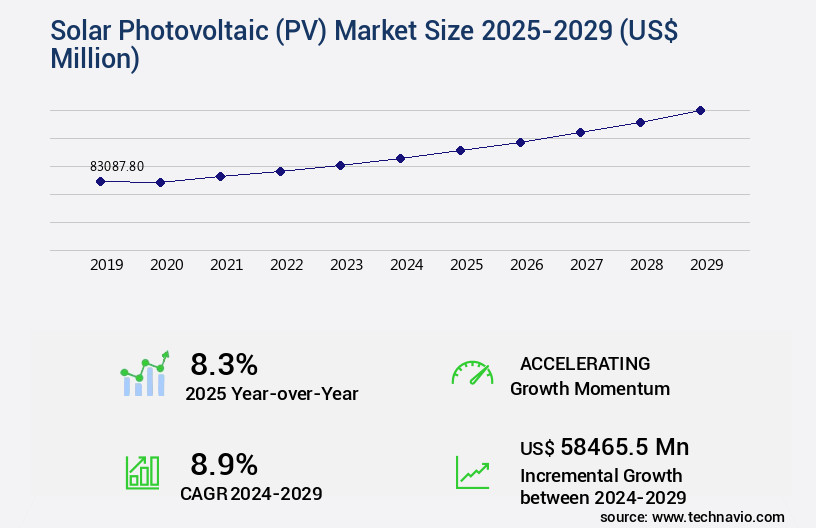
Get Key Insights on Market Forecast (PDF) Request Free Sample
How is the Solar Photovoltaic (PV) Market Segmented ?
The solar photovoltaic (pv) industry research report provides comprehensive data (region-wise segment analysis), with forecasts and estimates in "USD million" for the period 2025-2029, as well as historical data from 2019-2023 for the following segments.
- Deployment
- End-user
- Commercial
- Residential
- Utility
- Technology
- Monocrystalline silicon
- Polycrystalline silicon
- Thin-film
- Bifacial solar panels
- Others
- Geography
- North America
- Europe
- France
- Germany
- Italy
- Spain
- APAC
- China
- India
- Japan
- South Korea
- South America
- Rest of World (ROW)
By Deployment Insights
The ground-mounted segment is estimated to witness significant growth during the forecast period.
The market continues to evolve, with ground-mounted systems leading the charge in absorbing sunlight and converting it into electricity. This process, known as photovoltaic energy conversion, involves transferring the generated charge to power electronics inverters for grid integration. The demand for utility-scale solar PV systems has surged in recent years, driven by the growing global population and increasing electricity needs. Technological advancements, economies of scale, and industry competition have driven down installation costs, making solar energy a cost-effective alternative. Solar resource assessment, including solar irradiance modeling and energy yield optimization, plays a crucial role in maximizing system performance.
Thin film photovoltaics and silicon wafer production are two key areas of innovation, with bifacial solar panels and perovskite solar cells promising higher efficiency. Solar panel installation and maintenance, including string inverter technology and microinverter technology, are essential for optimizing system performance and lifespan. Solar energy harvesting is further enhanced by solar tracker systems, which increase capacity factor metrics. Renewable energy integration and electrical grid stability are ongoing challenges, addressed through energy storage systems and photovoltaic system design. Solar panel degradation is a critical concern, with anti-reflective coatings and capacity factor metrics essential for mitigating its impact. According to industry reports, solar PV systems are expected to generate over 1,000 TWh of electricity annually by 2025.
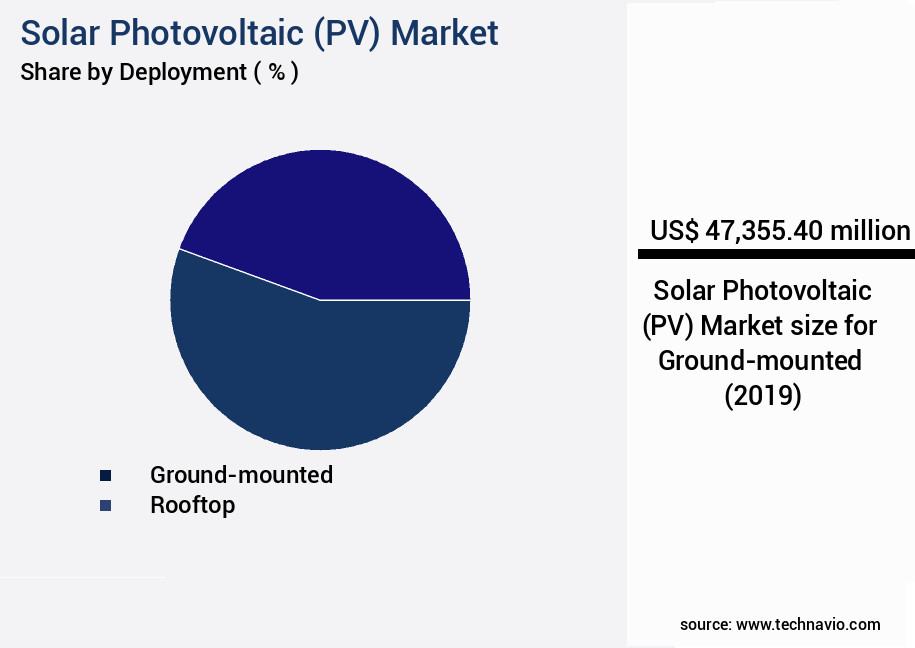
Request Free Sample
The Ground-mounted segment was valued at USD 47.36 billion in 2019 and showed a gradual increase during the forecast period.
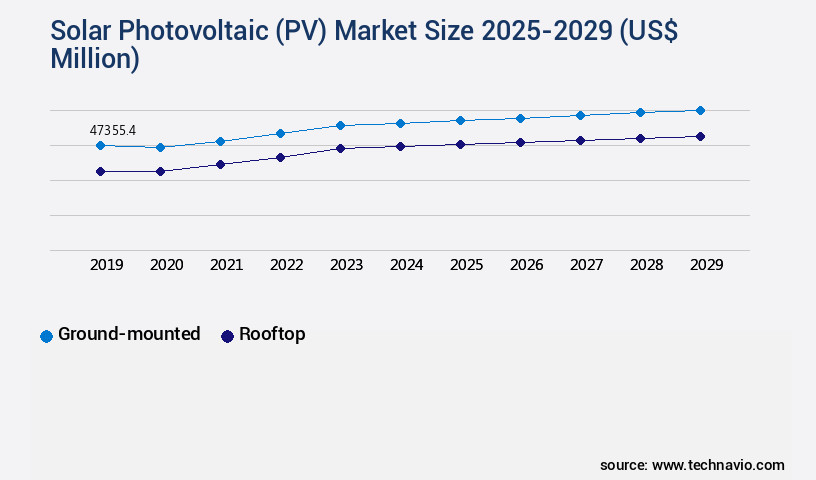
Request Free Sample
Regional Analysis
APAC is estimated to contribute 37% to the growth of the global market during the forecast period.Technavio's analysts have elaborately explained the regional trends and drivers that shape the market during the forecast period.
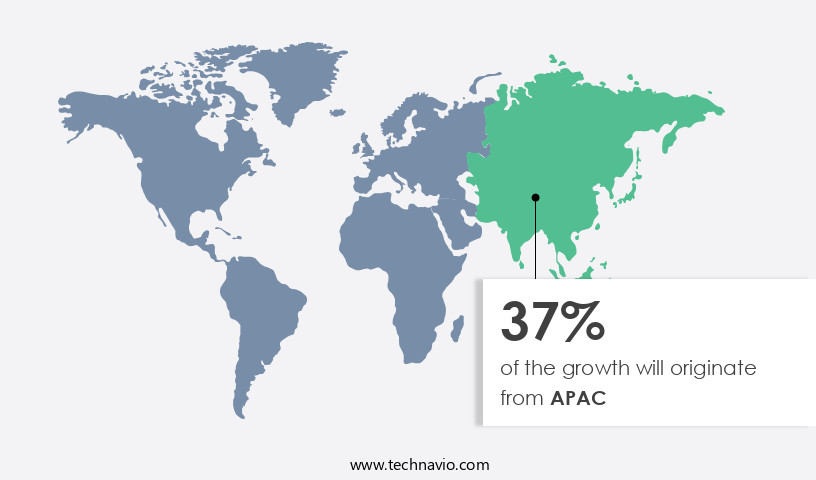
See How Solar Photovoltaic (PV) Market Demand is Rising in APAC Request Free Sample
The market in the Asia Pacific (APAC) region is poised for substantial expansion during the forecast period. In 2024, China, Japan, India, Australia, and South Korea emerged as the leading countries in the APAC solar PV market. Among these, China held a substantial market share. The primary growth driver for the solar PV market in APAC is the implementation of financial incentive programs such as Feed-in Tariffs (FiTs) in China, Japan, Thailand, and Vietnam. Furthermore, the solar PV markets in China and India are projected to expand significantly due to the increasing number of residential installations in these countries.
The electrification of rural areas, growing off-grid installations, and the declining cost of solar PV systems are additional factors fueling the market's growth during the forecast period.
Market Dynamics
Our researchers analyzed the data with 2024 as the base year, along with the key drivers, trends, and challenges. A holistic analysis of drivers will help companies refine their marketing strategies to gain a competitive advantage.
The market is experiencing significant growth as advanced materials and technologies continue to improve solar cell efficiency. This innovation is crucial for designing efficient pv systems for residential applications, ensuring maximum energy production. However, shading remains a challenge, impacting solar panel energy production and necessitating careful system design. Optimizing energy storage capacity for solar installations is another key focus area. As solar integration into the grid increases, mitigating grid instability issues becomes essential. Analyzing solar panel degradation mechanisms and implementing advanced techniques for solar energy forecasting help maintain system reliability. Evaluating different pv module technologies, minimizing energy losses in pv system inverters, and enhancing solar cell performance using anti-reflective coatings are ongoing efforts to boost efficiency and reduce costs. Measuring capacity factor using real-time data and assessing the reliability of various pv components are essential for maintaining optimal system performance. Effects of temperature on solar panel energy yield and exploring new solar cell manufacturing processes are critical research areas. Developing innovative solar tracking systems, improving grid integration via smart inverters, and managing solar energy fluctuations with energy storage are also important advancements. Evaluating solar panel lifespan and maintenance needs, as well as analyzing the cost-effectiveness of different pv systems, are crucial for ensuring long-term profitability and sustainability. Modeling solar resource availability for optimized placement is another key consideration for successful solar pv projects.
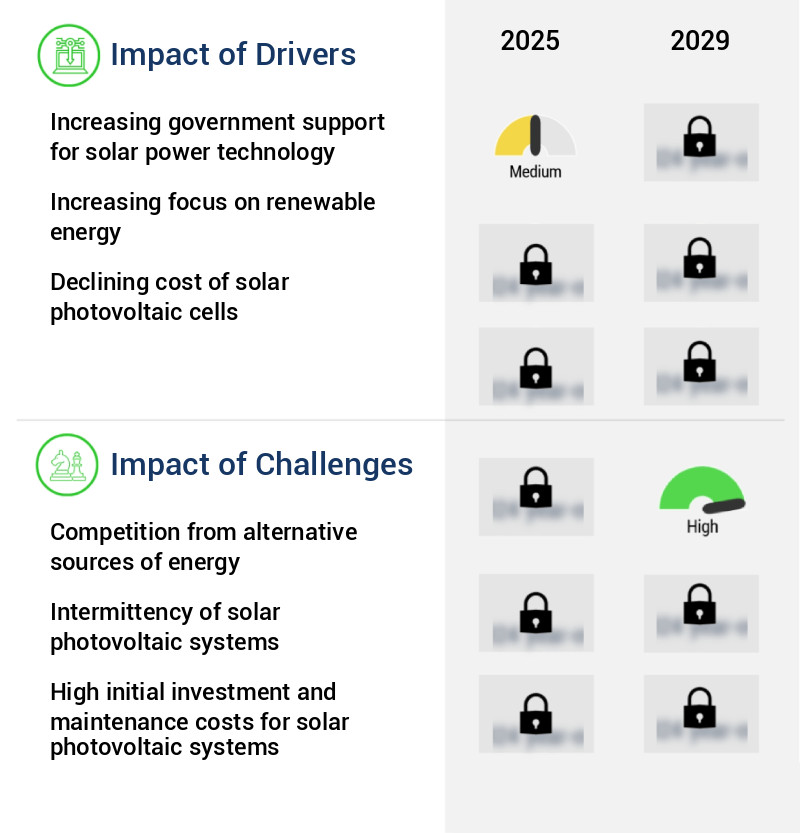
What are the key market drivers leading to the rise in the adoption of Solar Photovoltaic (PV) Industry?
- The significant growth in solar power technology's market expansion can be attributed primarily to the increasing governmental support and investment.
- The markets have experienced significant growth and transformation due to increasing global awareness of the need to reduce greenhouse gas emissions (GHG) and the depletion of fossil fuel resources. Governments worldwide have responded by offering incentives and subsidies to promote the adoption and development of solar power technologies, particularly solar photovoltaic cells. China, the US, and other countries have taken the lead in this regard, with China becoming a major manufacturer and consumer of solar energy. The solar energy sector's expansion is most prominent in these countries. The global shift towards renewable energy sources is driven by the recognition of the need to address carbon emission regulations and dwindling fossil fuel resources.
- Several countries, including China, India, the US, Vietnam, Japan, and Australia, are investing in solar energy to meet their energy demands sustainably. Solar PV technology's role in the global energy landscape is becoming increasingly significant, and its applications span various sectors, from residential to industrial and utility-scale projects.
What are the market trends shaping the Solar Photovoltaic (PV) Industry?
- Companies are increasingly focusing on decarbonization as the next market trend. This shift towards reducing carbon emissions is a mandatory and significant development in business practices.
- The market is experiencing significant growth and diversification, with companies investing in new projects to meet the increasing demand for renewable energy. In March 2023, Canadian Solar completed three solar power projects in Japan, totaling 42 MWp and capable of powering approximately 15,000 households. This equates to avoiding approximately 24,000 tons of annual carbon emissions. Similarly, in October 2023, Suniva restarted its 1 GW solar cell manufacturing facility in the U.S., marking a notable resurgence in domestic solar production. These developments underscore the expanding role of solar PV in various sectors and its contribution to decarbonization efforts.
What challenges does the Solar Photovoltaic (PV) Industry face during its growth?
- The expansion of the renewable energy sector poses a significant challenge to the growth of the traditional energy industry, as increasing competition from alternative sources threatens to erode market share and profitability.
- Solar energy, specifically Solar Photovoltaic (PV), is experiencing a dynamic evolution in the global energy market. Despite the competition from traditional energy sources like fossil fuels and natural gas, as well as emerging renewables such as wind and hydropower, the solar PV sector continues to gain traction. The intermittent nature of solar power and the high initial investment costs are significant challenges. For instance, while solar PV accounts for approximately 3% of the global electricity generation, its power output is not as consistent as that from fossil fuels or natural gas.
- Moreover, the declining cost of natural gas has led to an increase in its use for electricity generation, posing a challenge for solar PV. Nonetheless, the solar PV market's growth is driven by factors like technological advancements, government incentives, and the increasing awareness of environmental sustainability.
Exclusive Technavio Analysis on Customer Landscape
The solar photovoltaic (pv) market forecasting report includes the adoption lifecycle of the market, covering from the innovator's stage to the laggard's stage. It focuses on adoption rates in different regions based on penetration. Furthermore, the solar photovoltaic (pv) market report also includes key purchase criteria and drivers of price sensitivity to help companies evaluate and develop their market growth analysis strategies.
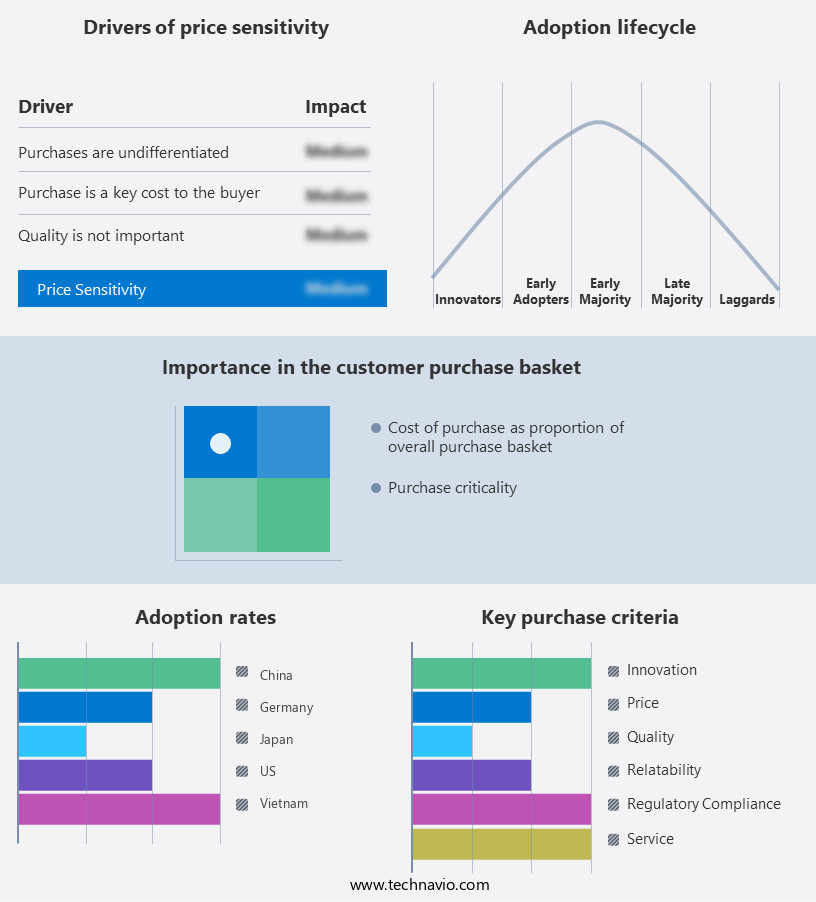
Customer Landscape of Solar Photovoltaic (PV) Industry
Competitive Landscape
Companies are implementing various strategies, such as strategic alliances, solar photovoltaic (pv) market forecast, partnerships, mergers and acquisitions, geographical expansion, and product/service launches, to enhance their presence in the industry.
ABB Ltd. - This company specializes in solar photovoltaic solutions, providing residential customers with innovative systems that harness the power of the sun to generate electricity. Their offerings encompass design, installation, and maintenance services for photovoltaic systems, contributing to sustainable energy adoption and reducing carbon footprints.
The industry research and growth report includes detailed analyses of the competitive landscape of the market and information about key companies, including:
- ABB Ltd.
- All Earth Renewables
- Canadian Solar Inc.
- Eaton Corp. plc
- EMMVEE SOLAR
- First Solar Inc.
- Hanwha Corp.
- JA Solar Technology Co. Ltd.
- JinkoSolar Holding Co. Ltd.
- LONGi Green Energy Technology Co. Ltd.
- Mitsubishi Electric Corp.
- Sharp Corp.
- SMA Solar Technology AG
- Sungrow Power Supply Co. Ltd.
- Tongwei Co. Ltd.
- Trina Solar Co. Ltd.
- Waaree Energies Ltd.
- Wuxi Suntech Power Co. Ltd.
- Yingli Solar
- Zhejiang CHINT Electrics Co. Ltd.
Qualitative and quantitative analysis of companies has been conducted to help clients understand the wider business environment as well as the strengths and weaknesses of key industry players. Data is qualitatively analyzed to categorize companies as pure play, category-focused, industry-focused, and diversified; it is quantitatively analyzed to categorize companies as dominant, leading, strong, tentative, and weak.
Recent Development and News in Solar Photovoltaic (PV) Market
- In January 2024, First Solar, a leading solar technology company, announced the launch of its Series 6 thin film photovoltaic (PV) module, boasting record-breaking efficiency of 21.3% . This technological advancement set a new industry standard for thin film solar modules.
- In March 2024, Tesla, the electric vehicle and renewable energy giant, and Panasonic, a major electronics manufacturer, expanded their strategic partnership by investing USD750 million in Tesla's Buffalo, New York, solar panel factory [Tesla Press Release]. This collaboration aimed to increase the production capacity of solar cells and panels for Tesla's energy storage and rooftop solar systems.
- In May 2024, SunPower Corporation, a leading solar technology company, and TotalEnergies, a global energy company, signed a strategic partnership to develop, construct, and operate solar power projects in the United States [TotalEnergies Press Release]. This collaboration marked SunPower's entry into the utility-scale solar market, expanding its presence beyond residential and commercial installations.
- In April 2025, the European Union passed the Solar Energy Directive, which mandated that at least 27% of the EU's energy consumption must come from renewable sources by 2030 [EU Press Release]. This policy change significantly increased the demand for solar PV systems in Europe, driving market growth and investment opportunities.
Dive into Technavio's robust research methodology, blending expert interviews, extensive data synthesis, and validated models for unparalleled Solar Photovoltaic (PV) Market insights. See full methodology.
|
Market Scope
|
|
Report Coverage
|
Details
|
|
Page number
|
209
|
|
Base year
|
2024
|
|
Historic period
|
2019-2023 |
|
Forecast period
|
2025-2029
|
|
Growth momentum & CAGR
|
Accelerate at a CAGR of 8.9%
|
|
Market growth 2025-2029
|
USD 58465.5 million
|
|
Market structure
|
Fragmented
|
|
YoY growth 2024-2025(%)
|
8.3
|
|
Key countries
|
US, China, India, Japan, Germany, South Korea, Spain, France, Brazil, and Italy
|
|
Competitive landscape
|
Leading Companies, Market Positioning of Companies, Competitive Strategies, and Industry Risks
|
Request Free Sample
Research Analyst Overview
- The market continues to evolve, driven by advancements in technology and increasing demand for renewable energy solutions. Solar irradiance modeling and energy yield optimization are key areas of focus, ensuring maximum efficiency in solar panel installation and photovoltaic energy conversion. Thin film photovoltaics and perovskite solar cells are gaining traction, offering potential cost savings and improved efficiency. Power Grid integration challenges persist, necessitating the use of energy storage systems and power electronics inverters for effective renewable energy integration. Solar resource assessment and forecasting are essential for optimizing solar panel performance and capacity factor metrics. Distributed generation systems and solar energy harvesting are expanding applications, with solar tracker systems and microinverter technology enhancing system efficiency.
- Solar panel manufacturing, from silicon wafer production to solar cell manufacturing and module technology, is a critical component of the market. Solar panel lifespan and degradation are significant concerns, with ongoing research to improve durability and extend lifespan. Bifacial solar panels and anti-reflective coatings are among the innovations addressing these challenges. The solar PV market is projected to grow at a robust rate, with industry experts anticipating a significant expansion in the coming years. For instance, a recent study revealed a 15% increase in global solar installations in 2020 compared to the previous year.
- The market's continuous dynamism underscores the importance of staying informed and adaptive to emerging trends and technologies.
What are the Key Data Covered in this Solar Photovoltaic (PV) Market Research and Growth Report?
-
What is the expected growth of the Solar Photovoltaic (PV) Market between 2025 and 2029?
-
What segmentation does the market report cover?
-
The report is segmented by Deployment (Ground-mounted and Rooftop), End-user (Commercial, Residential, and Utility), Technology (Monocrystalline silicon, Polycrystalline silicon, Thin-film, Bifacial solar panels, and Others), and Geography (APAC, Europe, North America, Middle East and Africa, and South America)
-
Which regions are analyzed in the report?
-
APAC, Europe, North America, Middle East and Africa, and South America
-
What are the key growth drivers and market challenges?
-
Who are the major players in the Solar Photovoltaic (PV) Market?
-
ABB Ltd., All Earth Renewables, Canadian Solar Inc., Eaton Corp. plc, EMMVEE SOLAR, First Solar Inc., Hanwha Corp., JA Solar Technology Co. Ltd., JinkoSolar Holding Co. Ltd., LONGi Green Energy Technology Co. Ltd., Mitsubishi Electric Corp., Sharp Corp., SMA Solar Technology AG, Sungrow Power Supply Co. Ltd., Tongwei Co. Ltd., Trina Solar Co. Ltd., Waaree Energies Ltd., Wuxi Suntech Power Co. Ltd., Yingli Solar, and Zhejiang CHINT Electrics Co. Ltd.
Market Research Insights
- The market is a dynamic and ever-evolving industry, characterized by continuous innovation and advancements. Two significant aspects of this market are the increasing demand for grid connection requirements and the industry's growth expectations. Approximately 60% of newly installed solar PV systems worldwide are connected to the grid. This figure underscores the importance of grid integration in the solar energy sector. This expansion is driven by various factors, including technological advancements and increasing global focus on renewable energy sources.
- For instance, a leading solar PV project developer recently reported a 20% increase in sales due to the successful implementation of advanced system monitoring software and shade analysis modeling. This success story highlights the potential for improved system performance and efficiency in the solar PV market. Additionally, the industry's growth trajectory is expected to continue, with renewable energy sources becoming an increasingly significant portion of the global energy mix.
We can help! Our analysts can customize this solar photovoltaic (pv) market research report to meet your requirements.
Get in touch
1 Executive Summary
- 1.1 Market overview
- Executive Summary - Chart on Market Overview
- Executive Summary - Data Table on Market Overview
- Executive Summary - Chart on Global Market Characteristics
- Executive Summary - Chart on Market by Geography
- Executive Summary - Chart on Market Segmentation by Deployment
- Executive Summary - Chart on Market Segmentation by End-user
- Executive Summary - Chart on Market Segmentation by Technology
- Executive Summary - Chart on Incremental Growth
- Executive Summary - Data Table on Incremental Growth
- Executive Summary - Chart on Company Market Positioning
2 Technavio Analysis
- 2.1 Analysis of price sensitivity, lifecycle, customer purchase basket, adoption rates, and purchase criteria
- Analysis of price sensitivity, lifecycle, customer purchase basket, adoption rates, and purchase criteria
- 2.2 Criticality of inputs and Factors of differentiation
- Overview on criticality of inputs and factors of differentiation
- 2.3 Factors of disruption
- Overview on factors of disruption
- 2.4 Impact of drivers and challenges
- Impact of drivers and challenges in 2024 and 2029
3 Market Landscape
- 3.1 Market ecosystem
- Parent Market
- Data Table on - Parent Market
- 3.2 Market characteristics
- Market characteristics analysis
4 Market Sizing
- 4.1 Market definition
- Offerings of companies included in the market definition
- 4.2 Market segment analysis
- 4.4 Market outlook: Forecast for 2024-2029
- Chart on Global - Market size and forecast 2024-2029 ($ million)
- Data Table on Global - Market size and forecast 2024-2029 ($ million)
- Chart on Global Market: Year-over-year growth 2024-2029 (%)
- Data Table on Global Market: Year-over-year growth 2024-2029 (%)
5 Historic Market Size
- 5.1 Global Solar Photovoltaic (PV) Market 2019 - 2023
- Historic Market Size - Data Table on Global Solar Photovoltaic (PV) Market 2019 - 2023 ($ million)
- 5.2 Deployment segment analysis 2019 - 2023
- Historic Market Size - Deployment Segment 2019 - 2023 ($ million)
- 5.3 End-user segment analysis 2019 - 2023
- Historic Market Size - End-user Segment 2019 - 2023 ($ million)
- 5.4 Technology segment analysis 2019 - 2023
- Historic Market Size - Technology Segment 2019 - 2023 ($ million)
- 5.5 Geography segment analysis 2019 - 2023
- Historic Market Size - Geography Segment 2019 - 2023 ($ million)
- 5.6 Country segment analysis 2019 - 2023
- Historic Market Size - Country Segment 2019 - 2023 ($ million)
6 Qualitative Analysis
- 6.1 The AI impact on Global Solar Photovoltaic (PV) Market
7 Five Forces Analysis
- 7.1 Five forces summary
- Five forces analysis - Comparison between 2024 and 2029
- 7.2 Bargaining power of buyers
- Bargaining power of buyers - Impact of key factors 2024 and 2029
- 7.3 Bargaining power of suppliers
- Bargaining power of suppliers - Impact of key factors in 2024 and 2029
- 7.4 Threat of new entrants
- Threat of new entrants - Impact of key factors in 2024 and 2029
- 7.5 Threat of substitutes
- Threat of substitutes - Impact of key factors in 2024 and 2029
- 7.6 Threat of rivalry
- Threat of rivalry - Impact of key factors in 2024 and 2029
- 7.7 Market condition
- Chart on Market condition - Five forces 2024 and 2029
8 Market Segmentation by Deployment
- 8.1 Market segments
- Chart on Deployment - Market share 2024-2029 (%)
- Data Table on Deployment - Market share 2024-2029 (%)
- 8.2 Comparison by Deployment
- Chart on Comparison by Deployment
- Data Table on Comparison by Deployment
- 8.3 Ground-mounted - Market size and forecast 2024-2029
- Chart on Ground-mounted - Market size and forecast 2024-2029 ($ million)
- Data Table on Ground-mounted - Market size and forecast 2024-2029 ($ million)
- Chart on Ground-mounted - Year-over-year growth 2024-2029 (%)
- Data Table on Ground-mounted - Year-over-year growth 2024-2029 (%)
- 8.4 Rooftop - Market size and forecast 2024-2029
- Chart on Rooftop - Market size and forecast 2024-2029 ($ million)
- Data Table on Rooftop - Market size and forecast 2024-2029 ($ million)
- Chart on Rooftop - Year-over-year growth 2024-2029 (%)
- Data Table on Rooftop - Year-over-year growth 2024-2029 (%)
- 8.5 Market opportunity by Deployment
- Market opportunity by Deployment ($ million)
- Data Table on Market opportunity by Deployment ($ million)
9 Market Segmentation by End-user
- 9.1 Market segments
- Chart on End-user - Market share 2024-2029 (%)
- Data Table on End-user - Market share 2024-2029 (%)
- 9.2 Comparison by End-user
- Chart on Comparison by End-user
- Data Table on Comparison by End-user
- 9.3 Commercial - Market size and forecast 2024-2029
- Chart on Commercial - Market size and forecast 2024-2029 ($ million)
- Data Table on Commercial - Market size and forecast 2024-2029 ($ million)
- Chart on Commercial - Year-over-year growth 2024-2029 (%)
- Data Table on Commercial - Year-over-year growth 2024-2029 (%)
- 9.4 Residential - Market size and forecast 2024-2029
- Chart on Residential - Market size and forecast 2024-2029 ($ million)
- Data Table on Residential - Market size and forecast 2024-2029 ($ million)
- Chart on Residential - Year-over-year growth 2024-2029 (%)
- Data Table on Residential - Year-over-year growth 2024-2029 (%)
- 9.5 Utility - Market size and forecast 2024-2029
- Chart on Utility - Market size and forecast 2024-2029 ($ million)
- Data Table on Utility - Market size and forecast 2024-2029 ($ million)
- Chart on Utility - Year-over-year growth 2024-2029 (%)
- Data Table on Utility - Year-over-year growth 2024-2029 (%)
- 9.6 Market opportunity by End-user
- Market opportunity by End-user ($ million)
- Data Table on Market opportunity by End-user ($ million)
10 Market Segmentation by Technology
- 10.1 Market segments
- Chart on Technology - Market share 2024-2029 (%)
- Data Table on Technology - Market share 2024-2029 (%)
- 10.2 Comparison by Technology
- Chart on Comparison by Technology
- Data Table on Comparison by Technology
- 10.3 Monocrystalline silicon - Market size and forecast 2024-2029
- Chart on Monocrystalline silicon - Market size and forecast 2024-2029 ($ million)
- Data Table on Monocrystalline silicon - Market size and forecast 2024-2029 ($ million)
- Chart on Monocrystalline silicon - Year-over-year growth 2024-2029 (%)
- Data Table on Monocrystalline silicon - Year-over-year growth 2024-2029 (%)
- 10.4 Polycrystalline silicon - Market size and forecast 2024-2029
- Chart on Polycrystalline silicon - Market size and forecast 2024-2029 ($ million)
- Data Table on Polycrystalline silicon - Market size and forecast 2024-2029 ($ million)
- Chart on Polycrystalline silicon - Year-over-year growth 2024-2029 (%)
- Data Table on Polycrystalline silicon - Year-over-year growth 2024-2029 (%)
- 10.5 Thin-film - Market size and forecast 2024-2029
- Chart on Thin-film - Market size and forecast 2024-2029 ($ million)
- Data Table on Thin-film - Market size and forecast 2024-2029 ($ million)
- Chart on Thin-film - Year-over-year growth 2024-2029 (%)
- Data Table on Thin-film - Year-over-year growth 2024-2029 (%)
- 10.6 Bifacial solar panels - Market size and forecast 2024-2029
- Chart on Bifacial solar panels - Market size and forecast 2024-2029 ($ million)
- Data Table on Bifacial solar panels - Market size and forecast 2024-2029 ($ million)
- Chart on Bifacial solar panels - Year-over-year growth 2024-2029 (%)
- Data Table on Bifacial solar panels - Year-over-year growth 2024-2029 (%)
- 10.7 Others - Market size and forecast 2024-2029
- Chart on Others - Market size and forecast 2024-2029 ($ million)
- Data Table on Others - Market size and forecast 2024-2029 ($ million)
- Chart on Others - Year-over-year growth 2024-2029 (%)
- Data Table on Others - Year-over-year growth 2024-2029 (%)
- 10.8 Market opportunity by Technology
- Market opportunity by Technology ($ million)
- Data Table on Market opportunity by Technology ($ million)
11 Customer Landscape
- 11.1 Customer landscape overview
- Analysis of price sensitivity, lifecycle, customer purchase basket, adoption rates, and purchase criteria
12 Geographic Landscape
- 12.1 Geographic segmentation
- Chart on Market share by geography 2024-2029 (%)
- Data Table on Market share by geography 2024-2029 (%)
- 12.2 Geographic comparison
- Chart on Geographic comparison
- Data Table on Geographic comparison
- 12.3 APAC - Market size and forecast 2024-2029
- Chart on APAC - Market size and forecast 2024-2029 ($ million)
- Data Table on APAC - Market size and forecast 2024-2029 ($ million)
- Chart on APAC - Year-over-year growth 2024-2029 (%)
- Data Table on APAC - Year-over-year growth 2024-2029 (%)
- 12.4 Europe - Market size and forecast 2024-2029
- Chart on Europe - Market size and forecast 2024-2029 ($ million)
- Data Table on Europe - Market size and forecast 2024-2029 ($ million)
- Chart on Europe - Year-over-year growth 2024-2029 (%)
- Data Table on Europe - Year-over-year growth 2024-2029 (%)
- 12.5 North America - Market size and forecast 2024-2029
- Chart on North America - Market size and forecast 2024-2029 ($ million)
- Data Table on North America - Market size and forecast 2024-2029 ($ million)
- Chart on North America - Year-over-year growth 2024-2029 (%)
- Data Table on North America - Year-over-year growth 2024-2029 (%)
- 12.6 Middle East and Africa - Market size and forecast 2024-2029
- Chart on Middle East and Africa - Market size and forecast 2024-2029 ($ million)
- Data Table on Middle East and Africa - Market size and forecast 2024-2029 ($ million)
- Chart on Middle East and Africa - Year-over-year growth 2024-2029 (%)
- Data Table on Middle East and Africa - Year-over-year growth 2024-2029 (%)
- 12.7 South America - Market size and forecast 2024-2029
- Chart on South America - Market size and forecast 2024-2029 ($ million)
- Data Table on South America - Market size and forecast 2024-2029 ($ million)
- Chart on South America - Year-over-year growth 2024-2029 (%)
- Data Table on South America - Year-over-year growth 2024-2029 (%)
- 12.8 US - Market size and forecast 2024-2029
- Chart on US - Market size and forecast 2024-2029 ($ million)
- Data Table on US - Market size and forecast 2024-2029 ($ million)
- Chart on US - Year-over-year growth 2024-2029 (%)
- Data Table on US - Year-over-year growth 2024-2029 (%)
- 12.9 China - Market size and forecast 2024-2029
- Chart on China - Market size and forecast 2024-2029 ($ million)
- Data Table on China - Market size and forecast 2024-2029 ($ million)
- Chart on China - Year-over-year growth 2024-2029 (%)
- Data Table on China - Year-over-year growth 2024-2029 (%)
- 12.10 India - Market size and forecast 2024-2029
- Chart on India - Market size and forecast 2024-2029 ($ million)
- Data Table on India - Market size and forecast 2024-2029 ($ million)
- Chart on India - Year-over-year growth 2024-2029 (%)
- Data Table on India - Year-over-year growth 2024-2029 (%)
- 12.11 Germany - Market size and forecast 2024-2029
- Chart on Germany - Market size and forecast 2024-2029 ($ million)
- Data Table on Germany - Market size and forecast 2024-2029 ($ million)
- Chart on Germany - Year-over-year growth 2024-2029 (%)
- Data Table on Germany - Year-over-year growth 2024-2029 (%)
- 12.12 Japan - Market size and forecast 2024-2029
- Chart on Japan - Market size and forecast 2024-2029 ($ million)
- Data Table on Japan - Market size and forecast 2024-2029 ($ million)
- Chart on Japan - Year-over-year growth 2024-2029 (%)
- Data Table on Japan - Year-over-year growth 2024-2029 (%)
- 12.13 South Korea - Market size and forecast 2024-2029
- Chart on South Korea - Market size and forecast 2024-2029 ($ million)
- Data Table on South Korea - Market size and forecast 2024-2029 ($ million)
- Chart on South Korea - Year-over-year growth 2024-2029 (%)
- Data Table on South Korea - Year-over-year growth 2024-2029 (%)
- 12.14 Spain - Market size and forecast 2024-2029
- Chart on Spain - Market size and forecast 2024-2029 ($ million)
- Data Table on Spain - Market size and forecast 2024-2029 ($ million)
- Chart on Spain - Year-over-year growth 2024-2029 (%)
- Data Table on Spain - Year-over-year growth 2024-2029 (%)
- 12.15 France - Market size and forecast 2024-2029
- Chart on France - Market size and forecast 2024-2029 ($ million)
- Data Table on France - Market size and forecast 2024-2029 ($ million)
- Chart on France - Year-over-year growth 2024-2029 (%)
- Data Table on France - Year-over-year growth 2024-2029 (%)
- 12.16 Brazil - Market size and forecast 2024-2029
- Chart on Brazil - Market size and forecast 2024-2029 ($ million)
- Data Table on Brazil - Market size and forecast 2024-2029 ($ million)
- Chart on Brazil - Year-over-year growth 2024-2029 (%)
- Data Table on Brazil - Year-over-year growth 2024-2029 (%)
- 12.17 Italy - Market size and forecast 2024-2029
- Chart on Italy - Market size and forecast 2024-2029 ($ million)
- Data Table on Italy - Market size and forecast 2024-2029 ($ million)
- Chart on Italy - Year-over-year growth 2024-2029 (%)
- Data Table on Italy - Year-over-year growth 2024-2029 (%)
- 12.18 Market opportunity by geography
- Market opportunity by geography ($ million)
- Data Tables on Market opportunity by geography ($ million)
13 Drivers, Challenges, and Opportunity/Restraints
- 13.3 Impact of drivers and challenges
- Impact of drivers and challenges in 2024 and 2029
- 13.4 Market opportunities/restraints
14 Competitive Landscape
- 14.2 Competitive Landscape
- Overview on criticality of inputs and factors of differentiation
- 14.3 Landscape disruption
- Overview on factors of disruption
- 14.4 Industry risks
- Impact of key risks on business
15 Competitive Analysis
- 15.2 Company ranking index
- 15.3 Market positioning of companies
- Matrix on companies position and classification
- 15.4 ABB Ltd.
- ABB Ltd. - Overview
- ABB Ltd. - Business segments
- ABB Ltd. - Key news
- ABB Ltd. - Key offerings
- ABB Ltd. - Segment focus
- SWOT
- 15.5 Canadian Solar Inc.
- Canadian Solar Inc. - Overview
- Canadian Solar Inc. - Business segments
- Canadian Solar Inc. - Key news
- Canadian Solar Inc. - Key offerings
- Canadian Solar Inc. - Segment focus
- SWOT
- 15.6 Eaton Corp. plc
- Eaton Corp. plc - Overview
- Eaton Corp. plc - Business segments
- Eaton Corp. plc - Key news
- Eaton Corp. plc - Key offerings
- Eaton Corp. plc - Segment focus
- SWOT
- 15.7 First Solar Inc.
- First Solar Inc. - Overview
- First Solar Inc. - Business segments
- First Solar Inc. - Key news
- First Solar Inc. - Key offerings
- First Solar Inc. - Segment focus
- SWOT
- 15.8 Hanwha Corp.
- Hanwha Corp. - Overview
- Hanwha Corp. - Product / Service
- Hanwha Corp. - Key news
- Hanwha Corp. - Key offerings
- SWOT
- 15.9 JA Solar Technology Co. Ltd.
- JA Solar Technology Co. Ltd. - Overview
- JA Solar Technology Co. Ltd. - Product / Service
- JA Solar Technology Co. Ltd. - Key news
- JA Solar Technology Co. Ltd. - Key offerings
- SWOT
- 15.10 JinkoSolar Holding Co. Ltd.
- JinkoSolar Holding Co. Ltd. - Overview
- JinkoSolar Holding Co. Ltd. - Product / Service
- JinkoSolar Holding Co. Ltd. - Key news
- JinkoSolar Holding Co. Ltd. - Key offerings
- SWOT
- 15.11 LONGi Green Energy Technology Co. Ltd.
- LONGi Green Energy Technology Co. Ltd. - Overview
- LONGi Green Energy Technology Co. Ltd. - Product / Service
- LONGi Green Energy Technology Co. Ltd. - Key news
- LONGi Green Energy Technology Co. Ltd. - Key offerings
- SWOT
- 15.12 Mitsubishi Electric Corp.
- Mitsubishi Electric Corp. - Overview
- Mitsubishi Electric Corp. - Business segments
- Mitsubishi Electric Corp. - Key offerings
- Mitsubishi Electric Corp. - Segment focus
- SWOT
- 15.13 Sharp Corp.
- Sharp Corp. - Overview
- Sharp Corp. - Business segments
- Sharp Corp. - Key news
- Sharp Corp. - Key offerings
- Sharp Corp. - Segment focus
- SWOT
- 15.14 SMA Solar Technology AG
- SMA Solar Technology AG - Overview
- SMA Solar Technology AG - Business segments
- SMA Solar Technology AG - Key offerings
- SMA Solar Technology AG - Segment focus
- SWOT
- 15.15 Trina Solar Co. Ltd.
- Trina Solar Co. Ltd. - Overview
- Trina Solar Co. Ltd. - Product / Service
- Trina Solar Co. Ltd. - Key news
- Trina Solar Co. Ltd. - Key offerings
- SWOT
- 15.16 Waaree Energies Ltd.
- Waaree Energies Ltd. - Overview
- Waaree Energies Ltd. - Product / Service
- Waaree Energies Ltd. - Key offerings
- SWOT
- 15.17 Wuxi Suntech Power Co. Ltd.
- Wuxi Suntech Power Co. Ltd. - Overview
- Wuxi Suntech Power Co. Ltd. - Product / Service
- Wuxi Suntech Power Co. Ltd. - Key news
- Wuxi Suntech Power Co. Ltd. - Key offerings
- SWOT
- 15.18 Zhejiang CHINT Electrics Co. Ltd.
- Zhejiang CHINT Electrics Co. Ltd. - Overview
- Zhejiang CHINT Electrics Co. Ltd. - Product / Service
- Zhejiang CHINT Electrics Co. Ltd. - Key offerings
- SWOT
16 Appendix
- 16.2 Inclusions and exclusions checklist
- Inclusions checklist
- Exclusions checklist
- 16.3 Currency conversion rates for US$
- Currency conversion rates for US$
- 16.4 Research methodology
- 16.7 Validation techniques employed for market sizing
- Validation techniques employed for market sizing
- 16.9 360 degree market analysis
- 360 degree market analysis
- 16.10 List of abbreviations







![]() Get the report (PDF) sent to your email within minutes.
Get the report (PDF) sent to your email within minutes.
Complimentary full Excel data with your report purchase.